As well as many inhabitants of Uzbekistan since my childhood I have got used to living in the house with national porcelain dishes: lagans, teapots, plates and many other things decorated with such native pattern “cotton”. I have never thought why talents of local craftsmen have revealed so widely and loved by the whole nation in several forms and ornaments. What is the reason of absence white as a cotton of ornamentally various Uzbek porcelain on our tables? I have tried to sort out these questions with a help of Daminov Gayrat Rakhimdjanovich, a member of academy of artists of Uzbekistan, the art critic and the skilful master on porcelain.
A little about the history.
According to one of the versions porcelain appeared in Asian land due to the cultural interests of Sarap-Mulk-Hanim, a beloved wife of Amir Temur. According to one of the versions she invited masters on porcelain from China where the porcelain craft is mentioned already with 4 AD (some sources specify also earlier terms).
Pursuant to another sources porcelain technique was brought by a dynasty of Yuan (1280-1386). That fact has no small importance, since acquaintance with local culture has not passed imperceptibly for Chinese craftsmen. During the Mink dynasty Chinese porcelain gets new dark blue color. This was done due to the application of «Muslim cobalt blue ». Meanwhile, it is necessary to note that there was interchange between knowledge and porcelain-formers. In spite of being used to manufacture convenient in life so-called «vital» ceramic utensils local craftsmen adopted more graceful Chinese forms. It is important to note that this stage in ceramic development of both cultures will leave indelible centuries similarity between porcelain products of craftsmen of China and Central Asia.
Despite the success at creation of artwork with a new porcelain raw material, the further manufacturing of porcelain did not go well among local craftsmen. Manufacturing porcelain products were replaced by faience, which was easier in processing and less costly. Further necessity for more utilitarian forms, as for example jugs for comfortable fulfillment of a ceremony “namaz”, also it is probable by virtue of absence of wide natural opportunities of extraction of necessary raw material, have returned a ceramic craft to continuation of manufacturing of pottery.
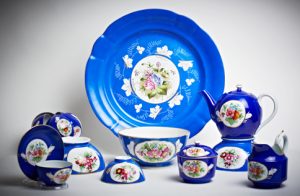
Meanwhile the intention to bring clear whiteness of porcelain and a practicality of utensils together has not left local ceramist and has led to the development of a transparent lead glaze “white angoba”. The glaze allowed to create an ideal background for the artist and had external similarity to porcelain.
The subsequent procession of porcelain has continued in 19th -20th centuries in Uzbek land. At the beginning, thanks to orders of Central Asia to Russian porcelain factories Gardner, Dulevo (later they continued to work in structure of company of porcelain -faience factories М.S. Kuznetsov).The goods were also delivered to Asia by workshops of Orlov and Ivanov, Kharpunov brothers, Kornilovih and Bateninih brothers.
Experts and true judges of porcelain mark that the most picturesque and bright goods were made exactly for Central Asia, taking into account its originality. Arabian language has been used for the inscription and dating utensils for eastern clients.
The first porcelain factory in the Central Asia started in Tashkent in 1953. On this note of the uncompleted porcelain epopee in Central Asia and in Uzbekistan in particular, I have addressed to one of founders of a modern porcelain craft in Uzbekistan – Daminov Gayrat Rakhimdjanovich.
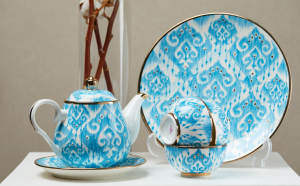
Professional history Gayrat Daminov totals more than 20 years. His works became significant ornaments at the State Museum of Art of Uzbekistan, A Museum of an Applied Art of Uzbekistan, Museum-manor Kuskov in Russia and among private collections worldwide. His sketches are used in the Koksheta Porcelain Factory in Kazakhstan. The emblems which were created by him are used by many significant organizations, including the Red Cross. The history of the true master began as a hobby of the boy for drawing. Seeing an obvious talent of the child, parents decided to send him to art school named P.P.Benkov. Then he enters to the Tashkent Architectural Institute. The next stage in life of the generated artist is work in above mentioned porcelain factory in Tashkent during 1977and 1995.
Telling about how everything began, Mr.Daminov recollects masters of porcelain from Russia and Belarus with gratitude who arrived to Tashkent factory for training new craft to mature, but inexperienced with porcelain ceramists and artists. All new was acquired by local masters quickly to the wonder of instructors. Acquired skills, love to bright colors and eastern ingenuity have led to unique, original porcelain products.
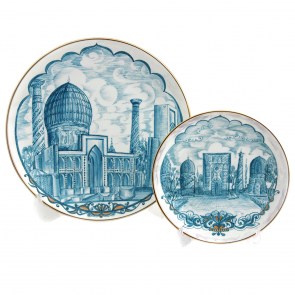
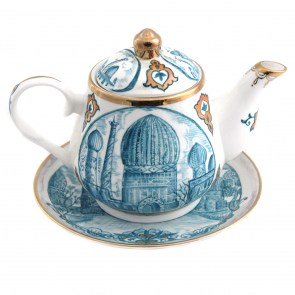
By then in the international porcelain branch already has received a high rating the bone porcelain prepared on the basis of bone ashes of large horned livestock. The main advantages of it was whiteness and thermo stability, hence durability and translucence. In order to achieve the same results, as at usage of bone ashes, Uzbek craftsmen in the led by Rizaev Anvar – Candidate of Chemical Science invented their know-how. The secret of the new invention consisted in addition of the stiffened stalks of a cotton-гузапая ́ in porcelain clay. The new invention has been successfully approved in a tandem with Gayrat Davletov the main artist of a factory (since 1982). The result has surpassed all expectations.”Even fingers were transilluminating” – says Gayrataka remembering Uzbek porcelain as white as snow and as light as feather. The further introduction of innovations demanded financial investment. In 1991, from the moment of gaining Independence by Republic the factory becomes joint-stock. People who were remote from understanding porcelain were ruling the factory. Very soon the factory stops its existence. The unique invention of local virtuosos remains without attention.
Talking about time of existence of a factory the master also marks that the high level work has been achieved due to high-quality of raw material which was delivered Duleyevo Paint Factory. Maintenance with paints of 58 porcelain and faience factories in the territory of all USSR was the main duty of Dulevo. Porcelain clay and other components were imported from Ukraine and other Russian factories. It is necessary to emphasize especially that the subject of raw material is a complicated question when the question is about its extractions in Uzbekistan. The matter is that high contents kaolin gives the whiteness to porcelain. The porcelain raw material extracted in Uzbekistan, contains as the smallest particles of ferric oxide. Therefore, there are dark dispersed dots on products – spots which reduce whiteness and worsen appearance of a product. Hence, the initial material extracted here should be cleared and enriched with appropriate kill from coloring impurity. In its turn it demands introduction of innovations and improvements of technical base of branch. For example in Uzbekistan, in the city of Angren, similar sort projects have already begun their job organized jointly with foreign investors.
Hearing it allowed me to draw the following conclusion that Uzbekistan can successfully develop a porcelain craft in different directions. For achievement of success in this business we possess little, in terms of base of technical and raw-materials but Angren is a visible example to this question which can be solved. At the same time people of our country possess with so many things in terms of skill which developed centuries among local population, about a delicate feeling of beauty and about high potential in achievement of competitive tops in the crafts demanding patience and diligence.
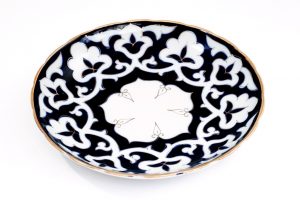
One more secret which has arisen within the years of activity in Tashkent factory is who is the author of the well-known pattern “cotton” which is closely associated with Uzbek porcelain. According to Gayrataka has told to us that creation of a pattern belongs to R. Arifdjhanov. But by virtue of complexity of a design of a pattern, the simplified variant of “cotton” for mass manufacturing has been developed by J. Karabaev.
Mr.Daminov likes to repeat the words of M.V. Lomonosov:” The Supreme achievement of ceramics is porcelain”. Undoubtedly porcelain is the noblest ceramics. However porcelain has hierarchy inside the group. As it has already been marked earlier, the most valuable porcelain is the one which has ideal whiteness. Value of porcelain is determined according to its “singing”: the more voiced and longer the sound is at percussion, the better a product is.
By virtue of value of porcelain there are situations in the market at times when faience products are confused with porcelain. In the help in such situations it is important to know that a bottom ring of a porcelain product is white and not covered with a glaze. It can be explained by manufacturing of porcelain the product is exposed to baking several times. As the temperature of baking of porcelain is much higher, than at faience products the glaze of bottom is necessarily cleaned off, otherwise having fused, it will paste a product to a support. Faience is covered with a glaze completely as its structure porous and the glaze serves as an original blanket on a product.Faience products also are less durable. With a lapse of time cracks appear on them and the internal surface grows dull.
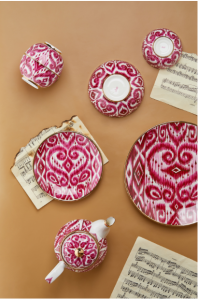
The price of porcelain which is white as a sugar varies a lot. The reason is not always obvious. Mr/Daminov is holding two cups (piala) in his hands. The first one was painted manually while the second is called “decol”a way of drawing of printed images. It is possible to paint with a product also with the help of a template. It is evident that a picture done by the master manually is alive. The flower ornament gives sensation of a flower in a hand, colorful pepper make fingers of hands hot while the paradise birds give inexpressible flavoring qualities to tea. According to Mr.Daminov it is quite simple to distinguish a manual painting from decol. The manual painting is a human factor whereas decol and a template is ideally drawn image. In the manual painting each side of a pattern, a sheet, branch as on a vivid bush differs in size, a saturation of color. Each time the hand of the master makes a different intake of paints, each second brings something new and allows creating more shades and forms for a person in contrast to machine.
In order to the ready masterpiece remained the same further craftsman uses stages of roasting. Each color demands its temperature and amount of roasting. Gayrat burns his works up to 5 times at a temperature of 1350 degrees. It is necessary to note that less qualitative porcelain products are burnt at 950 degrees and less times. Such porcelain product with low quality appears in the market. Unfortunately the price can sometimes exceed quality of such product.
Therefore it is necessary have a careful approach to a choice of porcelain. Porcelain is a thing which is kept carefully and passed from generation to generation. I have my grandmother’s porcelain set in the buffet. And you know what? It has not changed at all, its whiteness has remained untouched for years and a painting has saved its brightness. Even though it was purchased during hard times it breathes with luxury and a valuable ornament of a house. There is no doubt that it also will serve to the subsequent generations of our family loyally.

 Language
Language